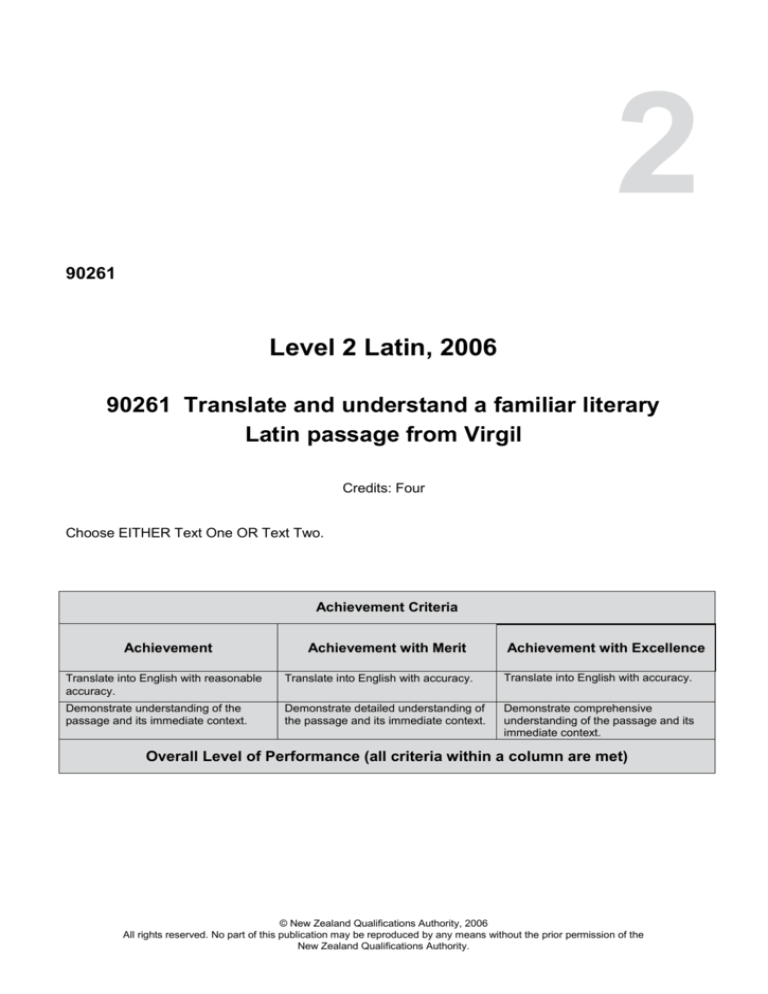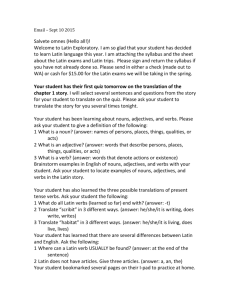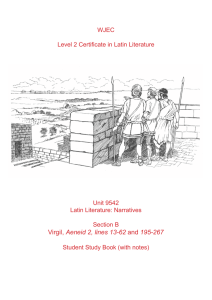
2
90261
Level 2 Latin, 2006
90261 Translate and understand a familiar literary
Latin passage from Virgil
Credits: Four
Choose EITHER Text One OR Text Two.
Achievement Criteria
Achievement
Achievement with Merit
Achievement with Excellence
Translate into English with reasonable
accuracy.
Translate into English with accuracy.
Translate into English with accuracy.
Demonstrate understanding of the
passage and its immediate context.
Demonstrate detailed understanding of
the passage and its immediate context.
Demonstrate comprehensive
understanding of the passage and its
immediate context.
Overall Level of Performance (all criteria within a column are met)
© New Zealand Qualifications Authority, 2006
All rights reserved. No part of this publication may be reproduced by any means without the prior permission of the
New Zealand Qualifications Authority.
You are advised to spend 45 minutes answering the questions in this booklet.
VIRGIL BOOK II
Choose ONE of the two texts: either Text One below or Text Two on page 6.
Answer ALL the questions that follow the text you have chosen.
EITHER: TEXT ONE
at Capys, et quorum melior sententia menti,
35
aut pelago Danaum insidias suspectaque dona
praecipitare iubent subiectisque urere flammis,
aut terebrare cavas uteri et temptare latebras.
scinditur incertum studia in contraria vulgus.
primus ibi ante omnes magna comitante caterva
40
Laocoon ardens summa decurrit ab arce,
et procul ‘o miseri, quae tanta insania, cives?
creditis avectos hostes? aut ulla putatis
dona carere dolis Danaum? sic notus Ulixes?
aut hoc inclusi ligno occultantur Achivi,
45
aut haec in nostros fabricata est machina muros,
inspectura domos venturaqe desuper urbi,
aut aliquis latet error; equo ne credite, Teucri.
quidquid id est, timeo Danaos et dona ferentes.’
sic fatus validis ingentem viribus hastam
50
in latus inque feri curvam compagibus alvum
contorsit. stetit illa tremens, uteroque recusso
insonuere cavae gemitumque dedere cavernae.
et, si fata deum, si mens non laeva fuisset,
impulerat ferro Argolicas foedare latebras,
55
Troiaque nunc staret, Priamique arx alta maneres.
(a)
Translate lines 35–44 (at Capys … notus Ulixes?) into English.
L2 Latin 2006, 90261 – page 2 of 6
(b)
Answer any TWO of (i)–(iii):
(i)
Who was Laocoon and whose priest was he?
(ii)
Explain why uteri (line 38) is an apt word in this context.
(iii)
Give TWO uses that Laocoon feared the gift might be put to.
(1)
(2)
(c)
Answer ONE of the following in detail, quoting Latin where applicable:
Either
(i)
Identify, in Latin, ONE figure of speech from lines 51–53 (in latus … cavernae.) and
describe the effect it conveys.
Or
(ii)
(d)
How is Aeneas feeling when he speaks the words in lines 54–56 (et, si fata …maneres.)?
With reference to the text, explain two ways Virgil has made these feelings clear.
Answer ONE of the following in detail:
Either
(i)
Or
(ii)
How is Laocoon portrayed in the passage above? Explain two ways Virgil has achieved
this. Quote in Latin from the passage to support your answer.
Scan lines 40 and 41 (primus … ab arce,) marking in the length of syllables, metrical feet,
elision (if applicable), and the main caesurae. Write your answer below.
Choose ONE of the scanned lines and describe the way in which the metre enhances the
meaning of the line.
L2 Latin 2006, 90261 – page 3 of 6
OR: TEXT TWO
vertitur interea caelum et ruit Oceano nox
250
involvens umbra magna terramque polumque
Myrmidonumque dolos; fusi per moenia Teucri
conticuere: sopor fessos complectitur artus.
et iam Argiva phalanx instructis navibus ibat
a Tenedo tacitae per amica silentia lunae
255
litora nota petens, flammas cum regia puppis
extulerat, fatisque deum defensus iniquis
inclusos utero Danaos et pinea furtim
laxat claustra Sinon. illos patefactus ad auras
reddit equus laetique cavo se robore promunt
260
Thessandrus Sthenelusque duces et dirus Ulixes,
demissum lapsi per funem, Acamasque Thoasque
Pelidesque Neoptolemus primusque Machaon
et Menelaus et ipse doli fabricator Epeos.
invadunt urbem somno vinoque sepultam;
265
caeduntur vigiles, portisque patentibus omnes
accipiunt socios atque agmina conscia iungunt.
(a)
Translate lines 252–262 (fusi … per funem,) into English.
L2 Latin 2006, 90261 – page 4 of 6
(b)
(c)
Answer any TWO of (i)–(iii):
(i)
Explain the Myrmidonumque dolos (line 252).
(ii)
Who was Sinon (line 259)? How was he in a position to undo the bolts?
(iii)
Why is Ulysses called dirus (line 261)?
Answer ONE of the following in detail, quoting Latin where applicable:
Either
(i)
Identify ONE figure of speech from line 265 (invadunt … sepultam;) and describe the
effect it conveys.
Or
(ii)
In what ways does Nature seem to be helping the Greeks? Quote from the Latin to
support your answer.
L2 Latin 2006, 90261 – page 5 of 6
(d)
Answer ONE of the following in detail:
Either
(i)
What are the contrasting moods in lines 250–253 (vertitur … artus.)? Discuss how Virgil
uses language to achieve this.
Or
(ii)
Scan lines 266–267 (caeduntur vigiles, … conscia iungunt.) marking in the length of
syllables, metrical feet, elision (if applicable), and the main caesurae. Write your answer
below.
Choose ONE of the scanned lines and comment on the effect created by the metre.
L2 Latin 2006, 90261 – page 6 of 6












